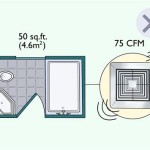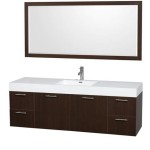Upflush System For Basement Bathroom
When it comes to adding a bathroom to your basement, one of the most important decisions you'll make is choosing the right drainage system. A traditional gravity-fed system relies on gravity to drain wastewater away from the bathroom fixtures, but this can be problematic in basements where the drain line is below the level of the sewer line. In these cases, an upflush system may be a better option.
An upflush system uses a pump to lift wastewater up to the sewer line. This allows you to install a bathroom in a basement even if the drain line is located below the level of the sewer line. Upflush systems are also a good option for bathrooms that are located far from the sewer line, as they can help to prevent clogs and backups.
There are two main types of upflush systems: macerating and non-macerating. Macerating systems use a blade to chop up solid waste into small pieces, which makes it easier to pump the wastewater up to the sewer line. Non-macerating systems do not have a blade, so they can only be used to pump wastewater that does not contain solid waste.
Upflush systems are a more expensive option than traditional gravity-fed systems, but they offer several advantages. First, they can be installed in basements where a gravity-fed system is not possible. Second, they can help to prevent clogs and backups. Third, they can be used to pump wastewater over long distances.
If you're considering adding a bathroom to your basement, an upflush system may be the right choice for you. These systems offer several advantages over traditional gravity-fed systems, and they can help you to create a beautiful and functional bathroom in your basement.
Benefits of Upflush Systems
There are several benefits to using an upflush system for your basement bathroom:
- Can be installed in basements where a gravity-fed system is not possible: Upflush systems are a good option for basements where the drain line is below the level of the sewer line. This is because upflush systems use a pump to lift wastewater up to the sewer line.
- Can help to prevent clogs and backups: Upflush systems can help to prevent clogs and backups by pumping wastewater away from the bathroom fixtures quickly and efficiently.
- Can be used to pump wastewater over long distances: Upflush systems can be used to pump wastewater over long distances, making them a good option for bathrooms that are located far from the sewer line.
Types of Upflush Systems
There are two main types of upflush systems: macerating and non-macerating.
Macerating systems use a blade to chop up solid waste into small pieces, which makes it easier to pump the wastewater up to the sewer line. Macerating systems are a good option for bathrooms that will be used to dispose of solid waste, such as toilets and sinks.
Non-macerating systems do not have a blade, so they can only be used to pump wastewater that does not contain solid waste. Non-macerating systems are a good option for bathrooms that will only be used to dispose of liquid waste, such as showers and bathtubs.
Choosing the Right Upflush System
When choosing an upflush system for your basement bathroom, it is important to consider the following factors:
- The type of wastewater that will be disposed of: If you will be disposing of solid waste, such as toilets and sinks, you will need a macerating system. If you will only be disposing of liquid waste, such as showers and bathtubs, you can use a non-macerating system.
- The distance that the wastewater will need to be pumped: Upflush systems can be used to pump wastewater over long distances, but the distance that the wastewater needs to be pumped will affect the size and cost of the system.
- The budget: Upflush systems are more expensive than traditional gravity-fed systems, so it is important to factor the cost of the system into your budget.
Installing an Upflush System
Installing an upflush system is a job that is best left to a professional plumber. However, if you are confident in your plumbing skills, you can install the system yourself. Here are the steps involved in installing an upflush system:
- Choose a location for the pump: The pump should be located in a dry, accessible location near the bathroom fixtures. The pump should also be located below the level of the sewer line.
- Install the pump: Follow the manufacturer's instructions to install the pump. The pump should be mounted on a solid surface and should be connected to the bathroom fixtures and the sewer line.
- Test the system: Once the system is installed, test it to make sure that it is working properly. Run water through the bathroom fixtures and check for leaks. The pump should turn on automatically when the water level reaches a certain level.
- Check the pump regularly: The pump should be checked regularly for signs of wear and tear. The pump should also be cleaned regularly to remove any debris that may have accumulated.
- Replace the pump impeller: The pump impeller should be replaced every few years. The impeller is a critical part of the pump, and it is important to replace it regularly to keep the system working properly.
- Flush the system with vinegar: The system should be flushed with vinegar every few months to remove any mineral deposits that may have accumulated. Flushing the system with vinegar will help to keep the system working properly and will prevent clogs.
Maintaining an Upflush System
Upflush systems require regular maintenance to keep them working properly. Here are some tips for maintaining an upflush system:

Everbilt 1 2 Hp Upflush System Sewage Ejector Pump Kit Sw07501tc The Home

Sewage Ejector Pump Vs Upflush Toilet Star Water Systems

Macerating Toilets Upflush Sewage Systems For Basements

Sanibest Pro Saniflo

Maceratingflo Ultra 750w Macerating Toilet Superior Powerful Space Saving Upflush System 4 Inlet Ideal For Basements Bathroom Pump Setups

Saniflo Upflush Toilet Saniplus

How To Install An Upflush Toilet

How To Add A Bathroom Basement The Easy Way Diy Family Handyman

How Does Saniflo Work And Can It Save You Thousands

Saniflo Upflush Toilet System Hudson Plumbing







